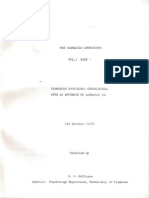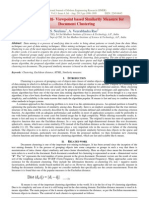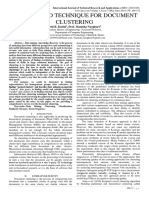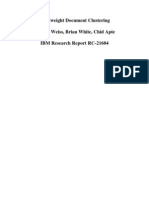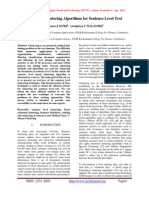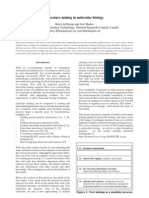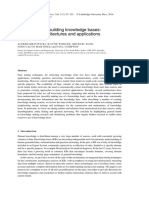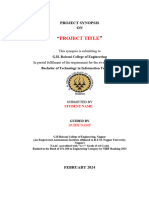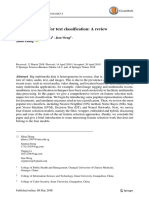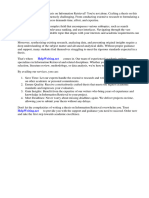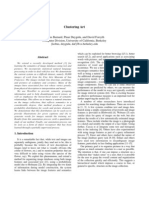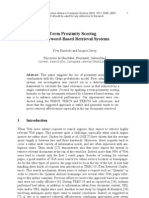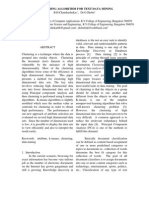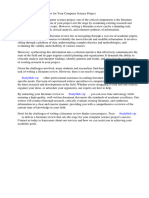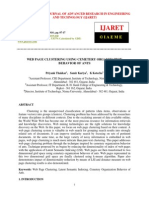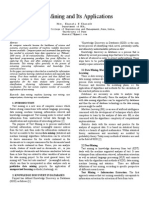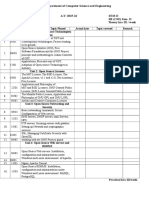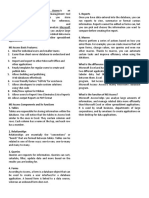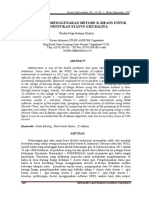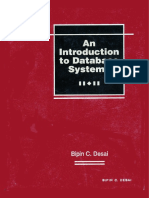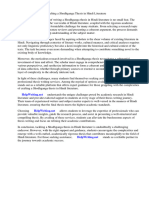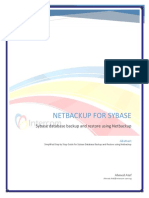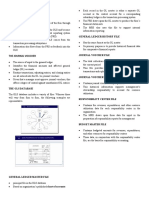Document Clustering Method Based On Visual Features
Document Clustering Method Based On Visual Features
Uploaded by
rajanCopyright:
Available Formats
Document Clustering Method Based On Visual Features
Document Clustering Method Based On Visual Features
Uploaded by
rajanOriginal Title
Copyright
Available Formats
Share this document
Did you find this document useful?
Is this content inappropriate?
Copyright:
Available Formats
Document Clustering Method Based On Visual Features
Document Clustering Method Based On Visual Features
Uploaded by
rajanCopyright:
Available Formats
Document Clustering Method Based on
Visual Features
Yucong Liu, Bofeng Zhang, Kun Xing, Bo Zhou
School of Computer Engineering & Science
Shanghai University
Shanghai, China
e-mail: liuyucong@163.com, bfzhang@shu.edu.cn
AbstractThere are two important problems worth conduct-
ing research in the fields of personalized information services
based on user model. One is how to get and describe user per-
sonal information, i.e. building user model, the other is how to
organize the information resources, i.e. document clustering. It
is difficult to find out the desired information without a proper
clustering algorithm. Several new ideas have been proposed in
recent years. But most of them only took into account the text
information, but some other useful information may have more
contributions for documents clustering, such as the text size,
font and other appearance characteristics, so called visual fea-
tures. This paper proposes a method to cluster the scientific
documents based on visual features, so called VF-Clustering
algorithm. Five kinds of visual features of documents are de-
fined, including body, abstract, subtitle, keyword and title. The
thought of crossover and mutation in genetic algorithm is used
to adjust the value of k and cluster center in the k-means algo-
rithm dynamically. Experimental result supports our approach
as better concept. In the five visual features, the clustering
accuracy and steadiness of subtitle are only less than that of
body, but the efficiency is much better than body because the
subtitle size is much less than body size. The accuracy of clus-
tering by combining subtitle and keyword is better than each
of them individually, but is a little less than that by combining
subtitle, keyword and body. If the efficiency is an essential
factor, clustering by combining subtitle and keyword can be an
optimal choice.
Keywods-document clustering; k-means; visual features;
genetic algorithm
I. INTRODUCTION
In recent years, personalized information services play an
important role in peoples life. There are two important prob-
lems worth researching in the fields. One is how to get and
describe user personal information, i.e. building user model,
the other is how to organize the information resources, i.e.
document clustering. Personal information is described ex-
actly only if user behavior and the resource what they look
for or search have been accurately analyzed. The effective-
ness of a personalized service depends on completeness and
accuracy of user model. The basic operation is organizing the
information resources. In this paper we focus on document
clustering.
At present, as millions of scientific documents available
on the Web. Indexing or searching millions of documents
and retrieving the desired information has become an in-
creasing challenge and opportunity with the rapid growth of
scientific documents. Clustering plays an important role in
analysis of user interests in user model. So high-quality
scientific document clustering plays a more and more impor-
tant role in the real word applications such as personalized
service and recommendation systems.
Clustering is a classical method in data mining research.
Scientific document clustering [6][8][9] is a technique which
puts related papers into a same group. The documents within
each group should exhibit a large degree of similarity while
the similarity among different clusters should be minimized.
In general, there are lots of algorithms about clustering
[1][5][10][13], including partitioning methods[5] (k-means,
k-medoids etc), hierarchical methods [16] (BIRCH, CURE,
etc), density-based methods (DBSCAN, OPTICS, etc), grid-
based methods (STING, CLIQUE, etc) and model-based
methods, etc.
In 1967, MacQueen first put forward the k-means
[2][3][4][7] clustering algorithm.The k-means method has
shown to be effective in producing good clustering results
for many practical applications. However it suffers from
some major drawbacks that make it inappropriate for some
applications. One major disadvantage is that the number of
cluster k must be specified prior to application. And another
is the sensitivity to initialization. The two drawbacks of k-
means not only affect the efficiency of the algorithm but also
influence clustering accuracy.
There are many existing document representation ap-
proaches [11], including Boolen Approach, Vector Space
Model (VSM), Probabilistic Retrieval Model and Language
Model. At present the most popular document representation
is Vector Space Model (VSM). In the 1960s, G. Salton and
other people proposed VSM. VSM is an algebraic model for
representing text documents as vectors of identifiers. Docu-
ments are represented as vectors, such as
= (
, ,
, ,
). The main advantages of this
2011 IEEE International Conferences on Internet of Things, and Cyber, Physical and Social Computing
978-0-7695-4580-6/11 $26.00 2011 IEEE
DOI 10.1109/iThings/CPSCom.2011.69
458
representation are its conceptual simplicity and its efficiency
of similarity computation. Its main disadvantage is the fact
that it loses important information about the original docu-
ment.The classic vector space model proposed by Salton,
Wong and Yang. The model is known as term frequency-
inverse document frequency model (TF-IDF) [12]. In docu-
ment clustering, the document size is not taken into account
when calculating the weight of clustering keywords using
TF-IDF.
The most important goal of this paper is to develop a
technique which will guide the user to get desired informa-
tion with proper clustering of scientific documents in web or
information retrieval systems. In this paper we propose a
high performance document clustering algorithm (called VF-
Clustering) based on documents visual features, including
body, abstract, subtitle, keyword and title. We integrate sev-
eral visual features to represent documents. We also use the
thought of crossover and mutation in genetic algorithm
[14][15] to improve the k-means algorithm. We merge and
add cluster centers during the process of clustering to adjust
the value of k and cluster center dynamically. Experimental
result shows that our approach is better in terms of clustering
performance of the scientific documents.
The paper is organized as follows. Section 2 expresses
the key steps of document clustering. Section 3 presents the
document clustering algorithm based on visual features. Sec-
tion 4 shows the implementation of VF-Clustering in Chi-
nese scientific document clustering. Section 5 concludes the
paper.
II. KEY STEPS OF DOCUMENT CLUSTERING
A. Document Segmentation
As it is necessary to segment document into words before
document feature extraction, in our research, we use lexicon-
based Word segmentation tools of the ICTCLAS (Institute of
Computing Technology, Chinese Lexical Analysis System).
However, its lexicon version is too low so that we add a
large amount of new words into this lexicon and remove stop
words from the result set of words segmentation.
B. Document Representation and Feature-Words Selection
As we know, Vector Space Model (VSM) is widely used
in document clustering, in which each n-dimensional vector
represents a document. In this paper, VSM can be
represented as (1).
d
= ((t
, w
), (
), , (
), (
))
where d
means the i-th document,
expresses the j-th
keyword words of the i-th document, and
represents the
weight of the j-th keyword in the i-th document.
This paper adopts classical TF-IDF as the clustering
keywords weight calculation method because it has an ad-
vantage in considering words occurrence frequency not only
in a document but also in the whole date set. Furthermore, in
this paper the size of each document is also taken into ac-
count, and the parameter weight is defined by (2).
=
,
_
.
()
()
where size (i) means the number of effective characters of
the i-th document
()
shows the average size of all
the document in date set, ,
_
expresses the words
occurrence frequency of keyword
_
appeared in document
, m is the number of documents containing
_
, and N is
the total number of document contained in a document set.
C. Similarity Measurement
After the document representation using VSM, a docu-
ment can be represented by a point in n-dimensional space,
while the similarity measurement between different docu-
ments was represented by the distance between correspond-
ing points. The closer the distance between the two points is
in n-dimensional, the more similar the documents
represented by the two points is, and vice versa. To calculate
the distance, there are many different methods, such as Ma-
halanobis distance and Euclidean distance, etc. The more
similar two documents is, the more similar coefficient close
to 1, conversely, the similar coefficient is close to 0. In this
paper, documents similarity here is presented by cosine si-
milarity which is defined by (3).
(, ) =
||
||||
||
For example
= (1,2,2,1,0)
= (0,1,2,1,1)
= 1 0 +2 1 +2 2 + 1 1 +0 1 = 7
||
|| = (1 1 + 2 2 + 2 2 + 1 1 + 0 0)
||
|| = (0 0 + 1 1 + 2 2 + 1 1 + 1 1)
(, ) =
7
10 7
= 0.7
III. DOCUMENT CLUSTERING ALGORITHMBASED ON
VISUAL FEATURES
The main characteristics of document clustering algo-
rithm based on visual features, so called VF-Clustering are as
follows:
1) Five kinds of visual features are defined according to
the analysis of content and structure of scientific document,
including body (B), abstract (A), subtitle (S), keyword (K)
and title (T). And the importance of these features to scientif-
ic document clustering will be compared through experi-
ments.
2) In view of the two drawbacks of k-means algorithm,
the thought of crossover and mutation in genetic algorithm is
used to improve the k-means algorithm. Adjust the values of
k and cluster center dynamically by merging and adding
cluster centers in the process of clustering.
The implementation of clustering algorithm introduces
below.
459
A. Document Presentation Based on Visual Features
As the most widely used document presentation method,
the mentioned model VSM represents document in two ways.
In one way we can segment words and select clustering
keywords according to words frequency by mainly analyz-
ing the body of the document, or put clustering keywords
selected in the first time into selection from the whole docu-
ment, and according to the clustering keywords position,
their weight shall be adjusted if they occurrences in title or
abstract. In the other way, only title and abstract are analyzed
to retrieve clustering keywords and do further clustering,
though effective, the result obtained in this way is not accu-
rate enough.
In this paper, a document representation based on visual
features is defined with a full consideration of the impor-
tance of each visual feature in the whole document. There-
fore, we segment words on the basis of every visual feature
independently and retrieve clustering keywords from each
part with features extraction method introduced above. And
according to the importance of every visual feature, it shall
be adjusted for the clustering keywords weight (
) of
comprehensive document representation, with
be ob-
tained by (4) and comprehensive document presentation
shown in (5).
= (
), (
), , (
), , (
)
where
means the weight of clustering keyword i in
body part, and the values of a, b, c, d, e must be either part
equal to 0 or all no less than 1. In our experiment we set the
values of a and b equal to 2, others equal to 1.
B. K-means Algorithm Optimization Based on Crossover
and Mutation
Take advantage of the idea of crossover and mutation in
genetic algorithm during the process of clustering, this algo-
rithm dynamically adjusts the values of k as well as cluster
center by means of mergence and addition, to achieve k-
means algorithm optimization.
Optimized clustering algorithm process is as follows:
Input: The initial number of cluster center k, Similarity
threshold . In our experiment we set the value of k equal to
4.
Output: The clustering clusters formed finally (the num-
ber of clusters not necessarily equals k).
Step 1 Initialize cluster centers. First of all, it is neces-
sary to check whether the newly selected cluster center is the
existed one. If it is, the cluster center can be reproduced. Or
else calculate the similarity between the current centers and
selected one and compare this similarity with . II the simi-
larity is bigger, reselect a document as a new center and go
back to execute step 1 once more until the number of cluster
center equal to k.
Step 2 Calculate the similarity between each data and
each cluster center, and then compare the biggest similarity
with a given threshold . On one hand, if the similarity is
bigger, the data shall be put into a cluster with its similarity
biggest.On the other hand, the thought of mutation in the
genetic algorithm is used in here, the data should be added
into cluster center as a new one which can cause cluster cen-
ter number change.
Step 3 Recalculate the center of each cluster which is de-
fined as the arithmetic average value of all data in this cluster.
For example, it is assumed that there are 3 documents in the
first cluster, which are
= (, 2), (, 3)
= (, 3), (, 3)
= ((, 4), (, 3), (, 1))
Their new cluster center should be:
= ,
, ,
, ,
= ((A, 3), (B, 3), (C, 0.33))
Step 4 Calculate the similarity for every pair of new clus-
ter centers obtained in step 3. The thought of crossover in
genetic algorithm is used in here. Two clusters have to be
merged if the similarity between them is bigger than . For
example, there are 2 cluster centers: center1= ((A, 3), (B, 4),
(C, 2)), center2= ((A, 2), (B, 4), (C, 3)), and the two merged
into one cluster center, that is,
= ,
, ,
, ,
= ((A, 2.5), (B, 4), (C, 2.5))
Step 5 Execute step 2, step 3 and step 4 once more, and
finish this process if cluster center reaches a stable value or
maximize iteration times, or else return to step 2 and contin-
ue to execute this process.
IV. IMPLEMENTATION OF VF-CLUSTERING IN CHINESE
SCIENTIFIC DOCUMENT CLUSTERING
A. Evaluation of Clustering Results
There is still no uniform standard for the evaluation of
document clustering results, however, precision rate and
recall rate which reflect two different aspects of quality clus-
tering must be taken into account together. Since F1 test
value combines the two precisely, we use the most common-
ly evaluation, precision rate, recall rate and F1 test value to
evaluate the effect of the document clustering.
Each artificial labeled theme T
i
in data set corresponds to
a clustering result set
in clustering result. Now we define
recall rate, precision rate and F1 as follows:
(6)
(7)
1 =
)
(8)
460
B. Experiment and Result Analysis
Text data sets are from 195 articles of Chinese scientific
and technical document in CNKI, including 47 articles of
Clustering Algorithm (CA), 58 articles of Data Mining (DM)
43 articles of Cloud Computing (CC) and 47 articles of Ge-
netic Algorithm (GA). We pre-treatment the data set, we
separately extract five visual features of each document to a
save to the database table. The part of the experimental orig-
inal data is shown in Fig. 1.
Figure 1. The part of the experiment original data
where the label is artificial classified marks, while nl shows
the clustering result.
The first step of the experiment: firstly, make word seg-
ment for five visual features independently, remove stop
words and extract clustering keywords; then, make a cluster-
ing for each visual feature that represents documents inde-
pendently. The experimental result is shown in TABLE I.
Where the k-means shows the basic clustering algorithm and
make the body representing the documents, all others adopt
the improved algorithm.
TABLE I. RESULTS OF CLUSTERING BY FIVE VISUAL FEATURES
k-means(%) B (%) A (%) S (%) K (%) T (%)
CA
R 76.60 76.60 74.47 76.60 55.32 53.19
P 83.72 83.72 53.03 85.71 92.86 48.93
F1 80.00 80.00 61.95 80.90 69.33 50.97
DM
R 93.10 93.10 91.38 93.10 86.25 87.93
P 90.00 90.00 82.81 88.52 84.85 82.26
F1 91.53 91.53 86.89 90.76 85.54 85.00
CC
R 93.02 93.02 90.69 90.70 95.35 93.02
P 90.69 90.69 88.38 86.04 97.62 78.43
F1 91.84 91.84 89.50 88.30 96.47 85.11
GA
R 93.62 93.62 40.43 89.36 100.00 91.79
P 84.62 84.62 95.00 86.27 79.66 58.11
F1 88.89 88.89 56.72 87.79 88.68 71.07
Through the analysis of the first step of the experimental
results, we could conclude as follows:
1) Because the value of the k is equal to 4, so the basic
algorithm and the improved algorithm to clustering have the
same results when make the body representing document
independently. But the clustering running time are reduced
when use the improved algorithm.
2) The clustering performance by visual features body
and subtitle are best in representing documents independent-
ly, and good steady is exhibited in these types of data sets.
Whats more, the visual feature body has slightly better clus-
tering results than subtitle.
3) The visual feature keyword is better than abstract and
title in clustering effect, moreover, abstract and title are poor
in the stability of the clustering result by representing docu-
ment independently. Among these three visual features, clus-
tering has a good effect in a new subject or a subject with
fewer applications. However, it has a relatively poor effect in
subject with extensive applications.
4) The visual features title has poor clustering results in
subject with extensive applications.
Under the first step of the experimental results, we make
an analysis of clustering results obtained through different
visual features representing the document independently. We
make different combinations of visual features to represent
the document and clustering. The result is shown in TABLE
II.
Summarize the analysis of the results of the second step
of experiment as follows:
1) From the whole analysis of the two results in TABLE I
and TABLE II, its obviously draw that the clustering result
of the comprehensive visual features is better than any single
visual feature in representing documents.
461
TABLE II. RESULTS OF CLUSTERING BY DIFFERENT COMBINATION
S, K (%) B, S (%) B, S, K (%) B, S, K, A (%) B, S, A, K, T (%)
CA
R 80.85 85.11 95.74 95.74 95.74
P 90.48 93.02 91.84 90.00 93.75
F1 85.39 88.89 93.75 92.78 94.74
DM
R 94.83 98.28 93.10 93.10 94.83
P 96.49 90.48 100.00 96.43 98.21
F1 95.65 94.21 96.43 94.74 96.49
CC
R 97.67 100.00 100.00 97.67 97.67
P 97.67 100.00 100.00 100.00 100.00
F1 97.67 100.00 100.00 98.82 98.82
GA
R 95.74 93.62 100.00 95.74 100.00
P 84.91 95.65 95.92 95.74 95.92
F1 90.00 94.62 97.92 95.74 97.92
2) Although the clustering results of visual features that
consist of subtitle and keyword are slightly better than the
visual feature body representing documents independently,
the effective number of characters of subtitle and keyword is
less than the bodys, so it greatly enhances the efficiency of
feature words selection when making words segment. This
way could be used to meet the high requirements of the clus-
tering results and efficiency.
3) The integrated independent visual feature includes
body, subtitle and keyword, in which each one has the best
clustering results to express text, and its clustering results is
almost the same as the one that integrate five visual features
to represent a document. Moreover, the clustering results of
these two combinations are the best, although the efficiency
is not so good. In order to meet the higher requirement of the
clustering results, we could combine body, subtitle and key-
word together to represent a document.
V. CONCLUSION
This paper implements a method to cluster the scientific
documents based on visual features (VF-Clustering). And
through the deep analysis of these clustering results we find
some useful information as follows:
1) In the five visual features, body representing docu-
ments independently to cluster have the best accuracy and
steadiness, and subtitle is next. However, the clustering ef-
fect of abstract, keyword and title are not very good, espe-
cially in the widely applied field of knowledge clustering.
2) The accuracy of clustering by combining subtitle and
keyword is better than each of them individually. Moreover,
operation time can be saved greatly for the less effective
characters in the two parts. If the efficiency is an essential
factor, clustering by combining subtitle and keyword can be
an optimal choice.
3) If the higher accuracy is demanded, clustering combin-
ing body, subtitle and keyword is a better choice.
This paper also uses the thought of crossover and muta-
tion in genetic algorithm to improve the k-means algorithm
and heightens the efficiency greatly by adjusting the values
of k and cluster center dynamically in the process of cluster-
ing.
ACKNOWLEDGMENT
This work is supported by Shanghai Leading Academic
Discipline Project (J50103) and Innovation Program of
Shanghai Municipal Education Commission (11ZZ85).
REFERENCES
[1] S. Guha, R. Rastogi, and K. Shim, An efficient clustering algorithm
for large databases, ACM SIGMOD international conference on
Management of data, Volume 27 Issue 2, June 1998.
[2] A. Likasa, and N. Vlassisb, Verbeekb. The global k-means
clustering algorithm. Pattern Recognition, 2003, pp. 451 461.
[3] J. A. Hartigan, and M. A. Wong, A K-Means Clustering Algorithm,
Journal of the Royal Statistical Society, Series C (Applied Statistics),
Vol. 28, No. 1,1979, pp.100-108.
[4] K. Wagsta, C. Cardie, S. Rogers, and S. Schroedl, Constrained K-
means Clustering with Background Knowledge, Proceedings of the
Eighteenth International Conference on Machine Learning, 2001, pp.
577-584.
[5] R. Dutta, I. Ghosh, A. Kundu, and D. Mukhopadhyay, An Advanced
Partitioning Approach of Web Page Clustering utilizing Content &
Link Structure, Journal of Convergence Information Technology
Volume 4, Number 3, 2009.
[6] J. L. Neto, A. D. Santos, and C. A. A. Kaestner, Alex A. Freitas,
Document Clustering and Text Summarization, Information
Processing and Management, 2000.
[7] J.M. Pena , J.A. Lozano, and P. Larranaga, An empirical comparison
of four initialization methods for the K-Means algorithm, Pattern
Recognition Letters, 1999, pp.1027-1040.
[8] L. Yanjun, M. Chung , and D. Holt, Text document clustering based
on frequent word meaning sequences, Data & Knowledge
Engineering, 2008, pp. 381404.
[9] E Rasmussen, P. Hall, and E. Cliffs, Clustering algorithms,
Information Retrieval, 1992, pp.419-442.
[10] A. K. Jain, and M. N. Murty, Data Clustering: A Review, ACM
Computing Surveys (CSUR), 1999, pp.264323.
[11] W. B. Cavnar, Using An N-Gram-Based Document Representation
With A Vector Processing Retrieval Model, Proc. of TREC-3 (Third
Text REtrieval Conference), Gaithersburg, 1994.
[12] G. Salton, and C. Buckley, Term-weighting approaches in automatic
text retrieval, Information Processing and Management 24, 513-523.
1988. Reprinted in: Sparck Jones, K. and Willet, P. Eds. Readings in
Information Retrieval, 1997, pp.323-328.
[13] N. Grira, Crucianu, and M. Boujemaa, Unsupervised and semi-
supervised clustering: a brief survey, 7th ACM SIGMM
international workshop on Multimedia information retrieval, 2005,
pp.9-16.
[14] U. Maulik, and S. Bandyopadhyay, Genetic algorithm-based
clustering technique, Pattern Recognition, 2000, pp.1455-1465.
[15] K. Krishna, and M. Narasimha Murty, Genetic K-Means Algorithm,
Item Identifer S, 1999, pp.1083-4419.
[16] J. F. Navarro, C. S. Frenk, and S. D. M. White, A universal density
profile from hierarchical clustering, The astrophysical jouranl, 1997,
pp.490-493.
462
You might also like
- MOLLISON 1976 The Tasmanian Aborigines ReportDocument6 pagesMOLLISON 1976 The Tasmanian Aborigines Reportaxiomatizadorr0% (1)
- El Sentimiento de Culpa A Guilty Feeling - Bho1l PDFDocument2 pagesEl Sentimiento de Culpa A Guilty Feeling - Bho1l PDFAntonio RamayoNo ratings yet
- Exam DP-900: Microsoft Azure Data Fundamentals-Skills MeasuredDocument7 pagesExam DP-900: Microsoft Azure Data Fundamentals-Skills MeasuredRofiq AhmedNo ratings yet
- A New Hierarchical Document Clustering Method: Gang Kou Yi PengDocument4 pagesA New Hierarchical Document Clustering Method: Gang Kou Yi PengRam KumarNo ratings yet
- K-Means Document Clustering Using Vector Space ModelDocument5 pagesK-Means Document Clustering Using Vector Space ModelBONFRINGNo ratings yet
- A Novel Multi-Viewpoint Based Similarity Measure For Document ClusteringDocument4 pagesA Novel Multi-Viewpoint Based Similarity Measure For Document ClusteringIJMERNo ratings yet
- MVS Clustering of Sparse and High Dimensional DataDocument5 pagesMVS Clustering of Sparse and High Dimensional DataInternational Journal of Application or Innovation in Engineering & ManagementNo ratings yet
- An Improved Technique For Document ClusteringDocument4 pagesAn Improved Technique For Document ClusteringInternational Jpurnal Of Technical Research And ApplicationsNo ratings yet
- Lightweight Document Clustering Sholom Weiss, Brian White, Chid Apte IBM Research Report RC-21684Document13 pagesLightweight Document Clustering Sholom Weiss, Brian White, Chid Apte IBM Research Report RC-21684cs_bd4654No ratings yet
- Survey On Clustering Algorithms For Sentence Level TextDocument6 pagesSurvey On Clustering Algorithms For Sentence Level TextseventhsensegroupNo ratings yet
- Clustering Algorithm With A Novel Similarity Measure: Gaddam Saidi Reddy, Dr.R.V.KrishnaiahDocument6 pagesClustering Algorithm With A Novel Similarity Measure: Gaddam Saidi Reddy, Dr.R.V.KrishnaiahInternational Organization of Scientific Research (IOSR)No ratings yet
- DoCEIS2013 - BrainMap - A Navigation Support System in A Tourism Case StudyDocument8 pagesDoCEIS2013 - BrainMap - A Navigation Support System in A Tourism Case StudybromeroviateclaNo ratings yet
- Literature Mining in Molecular BiologyDocument5 pagesLiterature Mining in Molecular BiologyVishwadeep SinghNo ratings yet
- Ijcet: International Journal of Computer Engineering & Technology (Ijcet)Document12 pagesIjcet: International Journal of Computer Engineering & Technology (Ijcet)IAEME PublicationNo ratings yet
- Learning Context For Text CategorizationDocument9 pagesLearning Context For Text CategorizationLewis TorresNo ratings yet
- A Computational Infrastructure For Research Synthesis in Software EngineeringDocument14 pagesA Computational Infrastructure For Research Synthesis in Software EngineeringDanilo Nãousoface MonteiroNo ratings yet
- Ljubesic08 DocumentDocument6 pagesLjubesic08 DocumentNikola BakaricNo ratings yet
- Introduction To Data Models Special Collection: Nicholas M. Weber and Karen M. WickettDocument3 pagesIntroduction To Data Models Special Collection: Nicholas M. Weber and Karen M. WickettRijal RojaliNo ratings yet
- Systematic Literature Review Computer ScienceDocument4 pagesSystematic Literature Review Computer Sciencefrvkuhrif100% (1)
- Document Clustering in Web Search Engine: International Journal of Computer Trends and Technology-volume3Issue2 - 2012Document4 pagesDocument Clustering in Web Search Engine: International Journal of Computer Trends and Technology-volume3Issue2 - 2012surendiran123No ratings yet
- Personalized Information Retrieval SysteDocument6 pagesPersonalized Information Retrieval Systenofearknight625No ratings yet
- Data Mining For Building Knowledge Bases: Techniques, Architectures and ApplicationsDocument27 pagesData Mining For Building Knowledge Bases: Techniques, Architectures and ApplicationsPablo Ernesto Vigneaux WiltonNo ratings yet
- 1120pm - 85.epra Journals 8308Document7 pages1120pm - 85.epra Journals 8308Grace AngeliaNo ratings yet
- State of The Art Document Clustering Algorithms Based On Semantic SimilarityDocument18 pagesState of The Art Document Clustering Algorithms Based On Semantic SimilarityAna ArianiNo ratings yet
- The Peculiarities of The Text Document Representation, Using Ontology and Tagging-Based Clustering TechniqueDocument4 pagesThe Peculiarities of The Text Document Representation, Using Ontology and Tagging-Based Clustering TechniqueКонстантин МихайловNo ratings yet
- A Study On The Architecture For Text Categorization and SummarizationDocument4 pagesA Study On The Architecture For Text Categorization and Summarizationsurendiran123No ratings yet
- Iaetsd-Jaras-Comparative Analysis of Correlation and PsoDocument6 pagesIaetsd-Jaras-Comparative Analysis of Correlation and PsoiaetsdiaetsdNo ratings yet
- Format Synopsis DPDocument12 pagesFormat Synopsis DPritikgajjalwarNo ratings yet
- Enabling Lazy Learning For Uncertain Data StreamsDocument7 pagesEnabling Lazy Learning For Uncertain Data StreamsInternational Organization of Scientific Research (IOSR)No ratings yet
- Deng Et Al. - 2019 - Feature Selection For Text Classification A ReviewDocument20 pagesDeng Et Al. - 2019 - Feature Selection For Text Classification A ReviewGHDaruNo ratings yet
- Information Retrieval Thesis TopicsDocument6 pagesInformation Retrieval Thesis Topicstheresasinghseattle100% (2)
- Computers in Industry: Suriati Akmal, Li-Hsing Shih, Rafael BatresDocument17 pagesComputers in Industry: Suriati Akmal, Li-Hsing Shih, Rafael BatresSendari NoviaNo ratings yet
- An Automatic Document Classifier System Based On Genetic Algorithm and TaxonomyDocument8 pagesAn Automatic Document Classifier System Based On Genetic Algorithm and TaxonomyJORGENo ratings yet
- 2019 Introduction To Neural Network Based Approaches For Question Answering Over Knowledge GraphsDocument34 pages2019 Introduction To Neural Network Based Approaches For Question Answering Over Knowledge Graphs宋广伟No ratings yet
- Eng-Clustering For Forensic Analysis-Pratik Abhay KolhatkarDocument8 pagesEng-Clustering For Forensic Analysis-Pratik Abhay KolhatkarImpact JournalsNo ratings yet
- Scientific Workflow Clustering Based On Motif DiscoveryDocument13 pagesScientific Workflow Clustering Based On Motif DiscoveryijcsesNo ratings yet
- A Scalable SelfDocument33 pagesA Scalable SelfCarlos CervantesNo ratings yet
- Research Paper On Information Retrieval SystemDocument7 pagesResearch Paper On Information Retrieval Systemfys1q18y100% (1)
- Clustering ArtDocument8 pagesClustering ArtIuliaNamaşcoNo ratings yet
- Coupling and Cohesion in Object-Oriented SystemsDocument34 pagesCoupling and Cohesion in Object-Oriented SystemsMochi ParkNo ratings yet
- A Survey On Text Categorization: International Journal of Computer Trends and Technology-volume3Issue1 - 2012Document7 pagesA Survey On Text Categorization: International Journal of Computer Trends and Technology-volume3Issue1 - 2012surendiran123No ratings yet
- A Mixed Method Approach For Efficient Component Retrieval From A Component RepositoryDocument4 pagesA Mixed Method Approach For Efficient Component Retrieval From A Component RepositoryLiaNaulaAjjahNo ratings yet
- A New Hybrid K-Means and K-Nearest-Neighbor Algorithms For Text Document ClusteringDocument7 pagesA New Hybrid K-Means and K-Nearest-Neighbor Algorithms For Text Document Clusteringputri dewiNo ratings yet
- 37 127 1 PB PDFDocument25 pages37 127 1 PB PDFbhattajagdishNo ratings yet
- Holistic Evaluation of XML Queries With Structural Preferences On An Annotated Strong DataguideDocument11 pagesHolistic Evaluation of XML Queries With Structural Preferences On An Annotated Strong DataguideAnonymous rVWvjCRLGNo ratings yet
- Clustering With Multiviewpoint-Based Similarity Measure: AbstractDocument83 pagesClustering With Multiviewpoint-Based Similarity Measure: AbstractSathishPerlaNo ratings yet
- A Survey of Deep Learning Approaches For OCR and DDocument14 pagesA Survey of Deep Learning Approaches For OCR and Dkarim dabNo ratings yet
- Monostori Acsc2001Document9 pagesMonostori Acsc2001kimtinh18012005No ratings yet
- Term Proximity Scoring For Keyword-Based Retrieval SystemsDocument12 pagesTerm Proximity Scoring For Keyword-Based Retrieval SystemsdatanomischNo ratings yet
- KmeanseppcsitDocument5 pagesKmeanseppcsitchandrashekarbh1997No ratings yet
- Computer Science Project Literature ReviewDocument6 pagesComputer Science Project Literature Reviewaflsbegdo100% (1)
- Harley Convnet Icdar15Document5 pagesHarley Convnet Icdar15Abhishek VNo ratings yet
- Report 116 SmitDocument11 pagesReport 116 SmitParth VlogsNo ratings yet
- Research Paper On Knowledge RepresentationDocument8 pagesResearch Paper On Knowledge Representationvbbcvwplg100% (1)
- Paper Web ClusteringDocument3 pagesPaper Web ClusteringshitalNo ratings yet
- DocumentDocument3 pagesDocumentp0w3r4u1m0r0nNo ratings yet
- Bachelor Thesis Psychology ExampleDocument4 pagesBachelor Thesis Psychology Exampledeborahquintanaalbuquerque100% (1)
- Document Clustering Using Particle Swarm OptimizationDocument7 pagesDocument Clustering Using Particle Swarm OptimizationRishi Sharma .No ratings yet
- Ijaret: ©iaemeDocument11 pagesIjaret: ©iaemeIAEME PublicationNo ratings yet
- Bachelor Thesis FHNW PDFDocument8 pagesBachelor Thesis FHNW PDFMonica Waters100% (2)
- Text Mining and Its ApplicationsDocument5 pagesText Mining and Its Applicationscompaq1501No ratings yet
- Python Machine Learning for Beginners: Unsupervised Learning, Clustering, and Dimensionality Reduction. Part 1From EverandPython Machine Learning for Beginners: Unsupervised Learning, Clustering, and Dimensionality Reduction. Part 1No ratings yet
- Teaching OSTDocument4 pagesTeaching OSTrajanNo ratings yet
- Connecting A Private Network To The Internet Using NAT/Route ModeDocument5 pagesConnecting A Private Network To The Internet Using NAT/Route ModerajanNo ratings yet
- CC Lab Manual - 16feb2015Document34 pagesCC Lab Manual - 16feb2015rajanNo ratings yet
- Microproceesor Lab ManualDocument5 pagesMicroproceesor Lab ManualrajanNo ratings yet
- Te CseDocument20 pagesTe Csepritamalde3595No ratings yet
- Resource Description and Access (RDA)Document7 pagesResource Description and Access (RDA)Alexis ObienaNo ratings yet
- Mona Sinar Pertiwi (Jurnal)Document12 pagesMona Sinar Pertiwi (Jurnal)Mona Sinar pertiwiNo ratings yet
- Academic Decision Support System For Choosing Information Systems Sub Majors Programs Using Decision Tree AlgorithmDocument10 pagesAcademic Decision Support System For Choosing Information Systems Sub Majors Programs Using Decision Tree AlgorithmAlex MaryusNo ratings yet
- Microsoft Access Is 5. ReportsDocument1 pageMicrosoft Access Is 5. ReportsRovin GarciaNo ratings yet
- Big Data EssayDocument6 pagesBig Data EssayRodolfo de LeonNo ratings yet
- Clustering Menggunakan Metode K-Means Untuk Menentukan Status Gizi BalitaDocument18 pagesClustering Menggunakan Metode K-Means Untuk Menentukan Status Gizi BalitaAji LaksonoNo ratings yet
- What Is An Oracle Nested TableDocument4 pagesWhat Is An Oracle Nested TableSHAHID FAROOQ100% (1)
- Tutorial 2 - HistogramDocument9 pagesTutorial 2 - HistogramAnwar ZainuddinNo ratings yet
- Dbms Lab Manual II Cse II SemDocument58 pagesDbms Lab Manual II Cse II SemYukta BhatnagarNo ratings yet
- Introduction To Geographic Information System: Prachi Misra Sahoo I.A.S.R.I., New Delhi - 110012Document10 pagesIntroduction To Geographic Information System: Prachi Misra Sahoo I.A.S.R.I., New Delhi - 110012Pradeep SinghNo ratings yet
- Essential SQL AlchemyDocument25 pagesEssential SQL AlchemyHareesh KumarNo ratings yet
- Intro To Data Analytics Activity TemplatesDocument11 pagesIntro To Data Analytics Activity TemplatesgianframendozaxNo ratings yet
- Tokenization: Token Normalization Is The Process of Canonicalizing Tokens So That Matches OccurDocument3 pagesTokenization: Token Normalization Is The Process of Canonicalizing Tokens So That Matches OccurhugoNo ratings yet
- An Introduction To Database Systems Bipin C.desaIDocument849 pagesAn Introduction To Database Systems Bipin C.desaIDr. Aaruni GoelNo ratings yet
- Creating A Student DatabaseDocument22 pagesCreating A Student DatabaseMANSI AGARWALNo ratings yet
- Shodhganga Thesis in Hindi LiteratureDocument7 pagesShodhganga Thesis in Hindi Literaturegloriamoorepeoria100% (2)
- Tableau 1 - IntroductionDocument30 pagesTableau 1 - IntroductionLalla FatiNo ratings yet
- 1903 Plaza Publica VSJ InfoDocument3 pages1903 Plaza Publica VSJ InfoAmir SeñerizNo ratings yet
- SmartSheet Testing - Learning LessonDocument39 pagesSmartSheet Testing - Learning LessonDiptendu MukherjeeNo ratings yet
- The Intersection of Privacy and Artificial IntelligenceDocument2 pagesThe Intersection of Privacy and Artificial Intelligencecolorful2154No ratings yet
- Module 1 - Avamar FundamentalsDocument52 pagesModule 1 - Avamar FundamentalsRazu MollahNo ratings yet
- Corfu DBDocument5 pagesCorfu DBKeshav RathiNo ratings yet
- Netbackup For SybaseDocument68 pagesNetbackup For SybasealiNo ratings yet
- File Based Approac VS Database ApproachDocument7 pagesFile Based Approac VS Database Approachnicos peeNo ratings yet
- ACWR 106 Assignment For Style ManualsDocument2 pagesACWR 106 Assignment For Style ManualsbesteNo ratings yet
- Part 2 - MemoDocument2 pagesPart 2 - MemoAshish KumarNo ratings yet
- Ais Module 3Document13 pagesAis Module 3Maxine ConstantinoNo ratings yet
